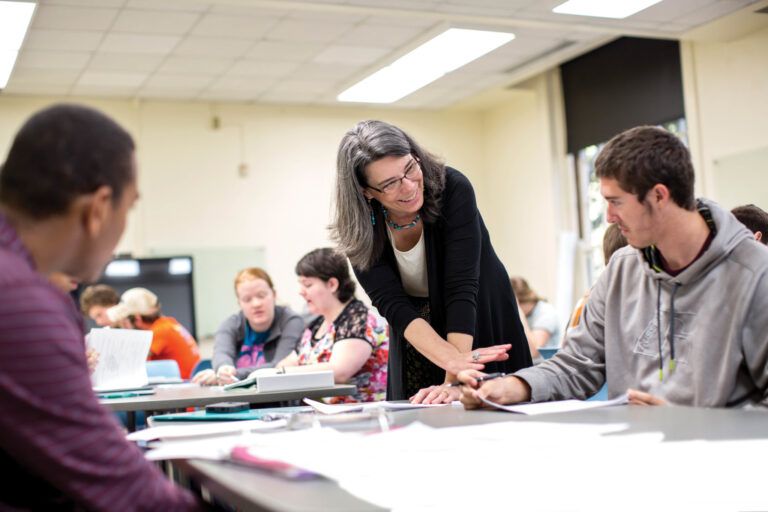By Jason Lee Miller
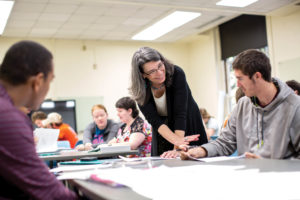
The academic lecture has been a standard feature of college campuses since the days of Plato. In the Hall Science Building, erected in 1928, that ancient tradition continues in a very felt way. Students plop themselves down into tiered rows of wooden seats handmade by College Crafts decades ago, facing forward and ready to absorb wisdom from a distance.
But, “science is not sitting in the classroom,” says Dr. Matthew Saderholm ’92, chair of Division I, which includes Berea’s biology, chemistry, mathematics, nursing, and physics programs. “Science is really a very active approach to understanding the physical world.”
In those words rest the seeds of debate, another tried-and-true academic standard, about the efficacy of lecture versus the real-world training that occurs in the laboratory.
“We all went through our educations being lectured to,” says Dr. Tracy Hodge, associate professor of physics, referring to the science faculty. “And we’re very good at it. If we weren’t good at taking notes and sitting through lectures, we wouldn’t have made it through undergraduate and Ph.D. programs. And it’s how we learned to teach, but experience tells me it’s not always the best way to teach.”
That being said, she adds, there’s always room for “a knockout lecture,” especially in higher-level, heavily theoretical courses like quantum mechanics. All of the faculty consulted for this article were careful to note that lecture still holds a special place for them, especially at the senior level.
Research shows that learning in the laboratory works well for students because it is experiential and active. By contrast the passivity of the lecture experience inspires less engagement, resulting in less learning. Our current building lacks the facilities and space to support more active learning approaches.
Evolution
There is an old story of a professor who says to the first-year students at the beginning of a tough science course, “Look to your right. Look to your left. One of these people will not be here at the end of the semester.”
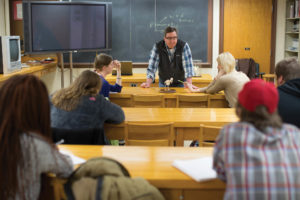
While faculty are no longer so discouraging, attrition, the rate at which students fail or withdraw, is highest among first-year students in introductory science courses at almost all colleges, including at Berea. Evidence shows that not only is the lecture approach not optimal for learning, but also that it contributes heavily to the high attrition rates found in first-year science courses. To increase the survival rate in difficult introductory courses, students and teachers have to evolve.
The faculty in the highly evidence-based Division I are committed to their part in this necessary evolution. For example, this fall, biology chair Dr. Megan Hoffman will use her sabbatical to focus on better ways of teaching biology, even though she is already a nationally recognized expert in Process Oriented Guided Inquiry Learning (POGIL). Developed in the mid-1990s, POGIL has been shown to be an effective way of teaching high school and college science courses.
Student-centered with an emphasis on group learning, POGIL exists under a broader category known as active learning. Students work in small groups on a specially designed activity with a set of information, such as graphs, images or videos, and a question to address about that information. They find their answers together, discuss them, and present them to the class. They “do” science, rather than hear about it. Just as importantly, the teacher steps away from her lectern and gets in the thick of it with them, guiding and explaining as necessary.
“Many, many studies,” says Hoffman, “suggest that when students work in this way, they understand the material better and retain it longer.”
These claims are reflected in attrition trends as well, she notes. “The number of students who get Ds, Fs, or withdraw from the class is going down. The number of students who get As, Bs, or Cs is going up.”
POGIL, and peer-assisted styles like it, takes students out of their seats — and sometimes out of their comfort zones. Part of the overall learning process is not just individually and materially focused; it’s teamwork focused. Students must present their findings to their peers, and if they have not participated fully in the work, they risk both letting down their teammates and looking lost at the front of the class.
As a student, Anna Skaggs ’17, a biology minor, speaks of the POGIL system from experience with it in her chemistry class. “I really liked it,” says Anna. “A lot of my classmates didn’t, but I’ve found that even though you have to struggle through some of the problems, you understand chemistry better by the time you get done.”
In short, group work requires more effort. It also requires social skills.
“Group work is the reality of what students are going to experience when they graduate,” says Dr. Ron Rosen, professor of biology. “When you get out of school, there are technicians, post-docs, graduate students, mentors. It’s a little micro-community. They need to learn to function with disagreements and different kinds of behaviors. One of our goals is to give students as much experience as possible.”
In conjunction with the development of group work experience, students within these teaching frameworks develop practical science application experience. In Rosen’s classes, first-year biology students participate in investigative laboratories, conducting real experiments and collecting real data in search of answers that nobody, including the professor, knows the answers to.
In Saderholm’s biochemistry course, students do not write the traditional research paper. Instead, they use a web application for developing 3-D virtual models of chemical structures and build a webpage to present to the class. In this way, Saderholm says, students learn more about protein structure and its connection to function.
The overarching goal is that when Berea science students enter the work world or graduate/professional school, they’ll be ready, and employers and research institutions will happily receive them.
While much of the science faculty is moving toward or already utilizing active learning techniques, there is still one major limitation: the building. It’s only designed for lecture.
Forward
On first meeting, Tracy Hodge might not strike a person as overly demonstrative. She’s factual, logical in a way that says, gently, here’s what is true. Though a physicist, bring up something abstract and heavily theoretical like string theory, and she’ll walk you back to the mathematics that enable an object to move through space and time. Here’s how it works on Earth, and in the sky. And there, in the sky especially, you’ll find her excitement. The astronomer’s smile widens at another point in the conversation: when talking about the new building, still just a hole in the dirt.
She speaks of the current building in makeshift terms, about how she has placed several white boards around the classroom for students to write their equations so she can see them, and the limitations of space. “In the new building,” she says, “the walls are going to be glass, so the white board space isn’t a problem. Students can just write on the glass.”
In this future, she continues, there are multiple projectors in the room so students don’t have to turn around in their seats, and the workspaces are large enough for true collaboration. “We’ll make it next to impossible to just lecture,” she smiles. “I think a student sitting in a classroom like that will say, ‘Why are you lecturing at me? Let’s do something!’”
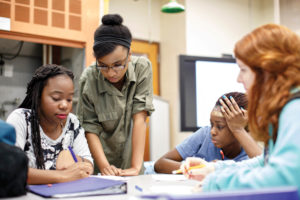
The Margaret A. Cargill Natural Sciences and Health Building will better support a teaching method Hodge has employed for the past 10 years, called SCALE-UP (Student-Centered Active Learning Environment with Upside-down Pedagogies), developed specifically for physics students at North Carolina State University.
SCALE-UP centers on students rather than the professor, and in doing so, students become active participants in their own education. It occurs not in a classroom, but a studio. There is no separation between lecture and laboratory, and students do not sit at desks, but at large round tables where they can talk to each other about their work as the professor floats around the room to assist. Since its inception, SCALE-UP has been introduced at over 200 educational institutions, including the Massachusetts Institute of Technology.
Hodge’s excitement about the new building is felt among other faculty, who, after a brief discussion with them about the present and the future, are starting now to solve problems still a fair distance down the road. Berea will have a solidly 21st century building, but how do we make certain the new building functions in the 22nd century?
“With the new building,” says Rosen, “we realized what we’re talking about now might be very different 20 or 30 years down the road. The new building has to be flexible.”
New Frontiers
The Berea College forest gets more attention for its history than its future. Its existence has become a symbol of conservation and sustainability, complete with charming images of mule teams pulling logs, and headlines about historical projects only this particular forest can support. Last year, the forest provided the rare kind of oak trees necessary to build a true replica of the Mayflower, docked at Plymouth.
It might be surprising, then, to hear Rosen mention the forest when speaking of the future of the science program. “We have a minor in forestry resource management,” he says, “but we’ve been talking about having a major in that. We have more than 9,000 acres of forest, a tremendous resource. It’s a little different, but it’s something that might be tied in with geology. We hope to bring back geology or earth science as a minor or major. There’s a lot of overlap.”
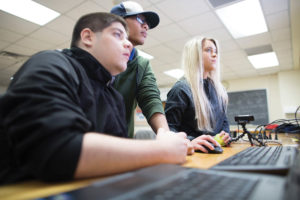
That sense of overlap dovetails with the general sense of possibilities the new science building carries. There is math in science. There is science in nursing. The new building will bring all these disciplines together under one planetary system.
“Our divisional structure has been pretty effective,” adds Saderholm. “We’ve utilized it to find common cause and align our efforts. We already have interdisciplinary approaches, biochemistry, biophysics. The most exciting discoveries are happening at the edges of fields where you can bring together two areas of expertise and see something new. There are real opportunities for cross-fertilization, and we are all very excited about bringing nursing and mathematics into our new building, as we will have more opportunities to develop interdisciplinary connections.” The new building will be able to support students pondering these new ideas.
Like the forest, science has its own narrative history. Great minds working in relative isolation, poor, misunderstood, unrecognized until, suddenly, a breakthrough. The current building supports the story, but Rosen and Saderholm are looking to flip the narrative on its head.
“We’ve been kind of isolated in terms of visibility,” Saderholm says. “The new building has a lot of glass in it, and you can see what people are doing.” Also, the new building’s location is along one of two main drags, along the north side of campus, a space with an expansive history of nothing to look at. It will be, quite literally, where liberal arts and STEM connect. And there, says Saderholm, is a final, uniquely Berean overlap of the disciplines.
“Service learning is another well-established learning approach. Berea has a long history of using it in other areas. We can do that in that our building, too. Last year, I coordinated with the public school to have our introductory chemistry students do demonstrations for the high school chemistry and physical science classes. They worked really hard on that. It really meant something that high school students were coming in and listening to them. I think both my students and the high school students benefited. Outreach works both ways, but it will be much easier to facilitate in our new building.”
Outreach is where all the scientists consulted for this article get dreamy. Hoffman speaks of toddlers holding snakes, elementary students looking through microscopes, of entire new staff positions for coordinating with local schools. Hodge, naturally, speaks of the sky.
“Astronomy is the ideal science for doing outreach,” she says. “Everybody loves to think about the planets and the stars, to look through a telescope at the moon or Jupiter or a nebula. We’ll have a larger planetarium — a digital learning theater with so much programming potential. We all agree that STEM education is important, but it’s difficult for teachers to find those kinds of enriching experiences for their students. We’d like to change that.”
With inspiration like that, you can bet they will.


